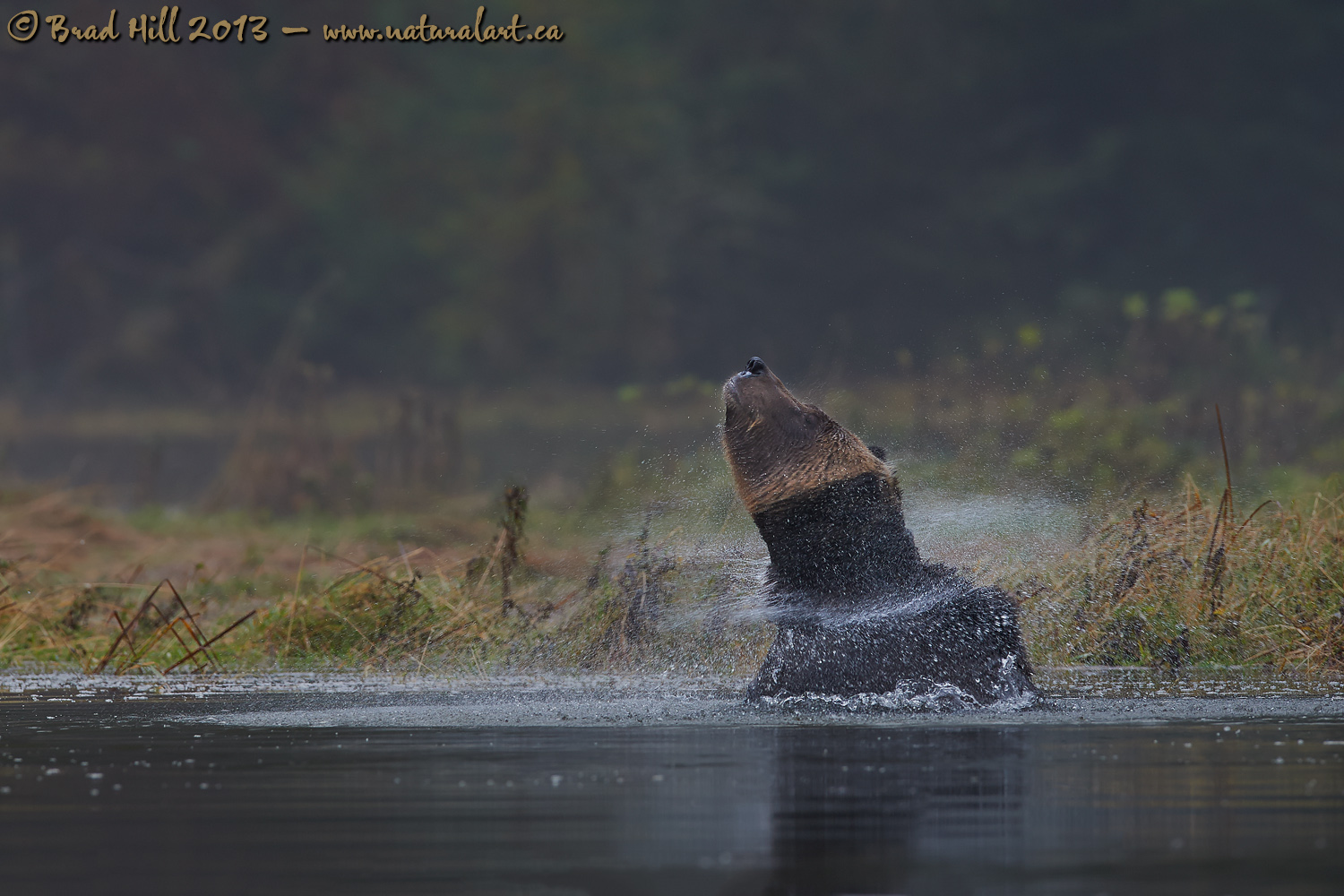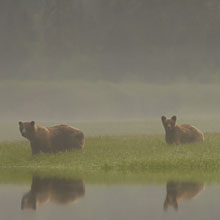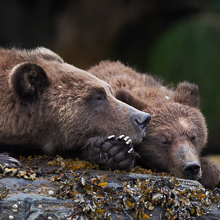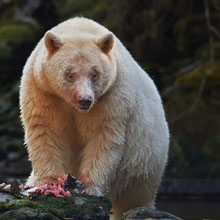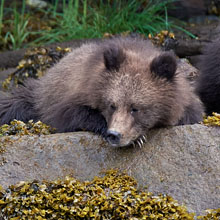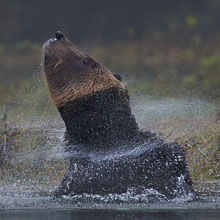Availability: Undetermined - Enquiries?
In the Field
Shakin'! Great Bear Rainforest, BC, Canada. October 6, 2013.
There are just a few things in life that are certainties - that we have to pay taxes, that our time on this planet is limited, and that when a wet grizzly shakes, the shutters start a clickin'! I caught this beautiful light-faced grizzly shaking during a trip to the Great Bear Rainforest in the autumn of 2013. This image was captured at close to high-noon, but the overcast skies reduced both the harshness and contrast of the scene and added a visually-pleasing softness to the image.
Effectively capturing motion using a still camera isn't an easy task. How the final image appears is obviously a function of the shutter speed used to capture the action, with the extreme ends of the spectrum being either a total blurring of the motion (by using a slow shutter speed) or a complete freezing of the action (by using a high shutter speed). Personally, I find those shots that are a combination of freezing and blurring the action to be the most visually appealing. The frozen parts of the action (the sharp bits - like the snout of this bear) act as an "anchor" that normally attract the viewer's eye first, while the blurred parts (like the fur and water on this bear's neck) imply motion and are normally the next part of the image explored by a viewer's eye. The trick in effectively producing these tricky "freeze-biur" combinations is picking exactly the right shutter speed.
And, this leads into the one of the most common questions I get in the field, which is this: "Exactly what shutter speed do I need to freeze action - and what shutter speed do I need to blur action?". My answer: I don't know. Huh?
Well, the reason I don't know is that there are a number of variables involved with choosing the right shutter speed to freeze or blur the action. But all the variables come down to the same thing, and the key issue to consider is how many pixels that the moving parts of the scene are crossing per unit time. Huh? Consider two scenarios: a wolf running across your viewfinder at a distance of 200 meters, and a wolf running across your viewfinder at a distance of 20 meters (and assume that the same focal length is used in both instances). The subject will be crossing far more pixels per unit time (ANY unit of time) when it is 20 meters away than when it is 200 meters away. Thus, a higher shutter speed is needed to freeze the wolf at 20 meters than the one at 200 meters. Now, just to complicate things further, think about what happens when you switch from using a 12 MP Nikon D3s to a 36 MP D800. Way more pixels per inch, and thus WAY more pixels for a moving object to cross per unit time. SO...you'll need a higher shutter speed to freeze action with a D800 than a D3s.
And, this is also true of that "other kind" of motion too (camera shake) - you need higher shutter speeds to remove camera shake in a high resolution camera than you do in a lower resolution camera!
So...now you get a feel for why my answer to the "what shutter speed do I need?" question is "I don't know." What about the tricky freeze-blur combinations? Well...all I can say is this: it takes a lot of experience (and methodically reviewing of metadata and shutter speeds used to capture past shots) before any photographer can effectively judge and choose the shutter speed to use to get the effect they're looking for. Hey, if it was easy, everyone could do it! ;-)
This shot? 1/400s.
This is a shot that needs to be seen at higher resolution to be appreciated...so here's a 2400 pixel for your perusal:
• Shakin'!: Download 2400 pixel image (JPEG: 1.3 MB)
ADDITIONAL NOTES:
1. This image - in all resolutions - is protected by copyright. I'm fine with personal uses of it (including use as desktop backgrounds or screensavers on your own computer), but unauthorized commercial use of the image is prohibited by law. Thanks in advance for respecting my copyright!
2. This image was captured during my "Into the Great Bear Rainforest"" instructional photo tour in the autumn of 2013. Each year I offer trips into two different parts of the Great Bear Rainforest as well as one to photograph aquatic mammals and oceanscapes near the northern tip of Vancouver Island. And, in selected years, I also offer photo tours to locations to capture other highly sought-after subjects, such as various boreal owl species and wildlife of Canada's Arctic. Details about these trips can be found on the Photo Tours page of this website.
3. Like all wildlife photographs on this website, this image was captured following the strict ethical guidelines described in The Wildlife FIRST! Principles of Photographer Conduct. I encourage all wildlife photographers to always put the welfare of their subjects above the value of their photographs.
Behind the Camera
Shakin'! Great Bear Rainforest, BC, Canada. October 6, 2013.
Digital Capture; Compressed RAW (NEF) 14-bit format; ISO 560.
Nikon D4 paired with Nikkor 400mm f2.8 VR lens. Hand-held from floating Zodiac. VR on and in normal mode.
1/400s @ f6.3; -0.33 stop exposure compensation from matrix-metered exposure setting.
At the Computer
Shakin'! Great Bear Rainforest, BC, Canada. October 6, 2013.
RAW Conversion to 16-bit TIFF, including first-pass/capture sharpening using Capture One Pro version 7. Three raw variants (different versions of a single raw capture) differing by a total of 1 stop in total exposure.
Further digital corrections on resulting 16-bit TIFF files using Adobe's Photoshop CC and Light Craft's LightZone. Photoshop adjustments included compositing (blending) of the three exposure variants, minor selective contrast adjustment (via a selective application of a tonal curve adjustment layer), minor selective colour saturation and desaturation, and sharpening for web output. Final tone tweaking performed using tonemapper/re-light tool in LightZone.
Conservation
Shakin'! Great Bear Rainforest, BC, Canada. October 6, 2013.
Ten percent of the revenue generated by this image will be donated to Raincoast*.
Species Status in Canada**: Special Concern (May 2002).
While Grizzly Bears (Ursus arctos) are not technically listed as "Endangered" in Canada, they have been extirpated from most of their historical range. Grizzly Bears are far more sensitive to intrusion/disturbance in their habitat than are Black Bears and are being increasingly forced into marginal habitat by human encroachment. The Great Bear Rainforest along the central and northern coast of British Columbia is one of the last strongholds of the Grizzly Bear in Canada, and even this population is coming under increasing pressure.
On December 18, 2017 the government of British Columbia banned grizzly hunting across the entire province. This major conservation victory came after decades of tireless work by many dedicated conservationists and ecologists and, most importantly, it reflects the opinion of the vast majority of British Columbians. And, it means that AT LEAST while the current government remains in power grizzlies are finally "safe" in British Columbia.
Now that we've at least temporarily won the battle to save grizzlies in BC, it's time to re-focus our efforts toward protecting ALL of BC's carnivores, including Gray Wolves, Black Bears, Cougars, Wolverines, and more! Simply put, there are no ecological, economic, or ethical arguments supporting the trophy hunting of carnivores.
In a great first step towards ending the hunting of carnivores throughout BC the Raincoast Conservation Foundation has developed a program designed to protect ALL carnivores within the Great Bear Rainforest. Details about this program can be found on this page on Raincoast's website. Check it out and, better yet, make a donation to help Raincoast purchase the remaining commercial hunting tenures in the Great Bear!
*The Raincoast Conservation Society (and Foundation) is an effective and efficient organization that has been fighting for protection of this unique habitat. If you are looking for a meaningful way to contribute to the conservation of this amazing ecosystem, Raincoast will provide maximal "bang" for your conservation dollars.
**as determined by COSEWIC: The Committee on the Status of Endangered Wildlife in Canada












